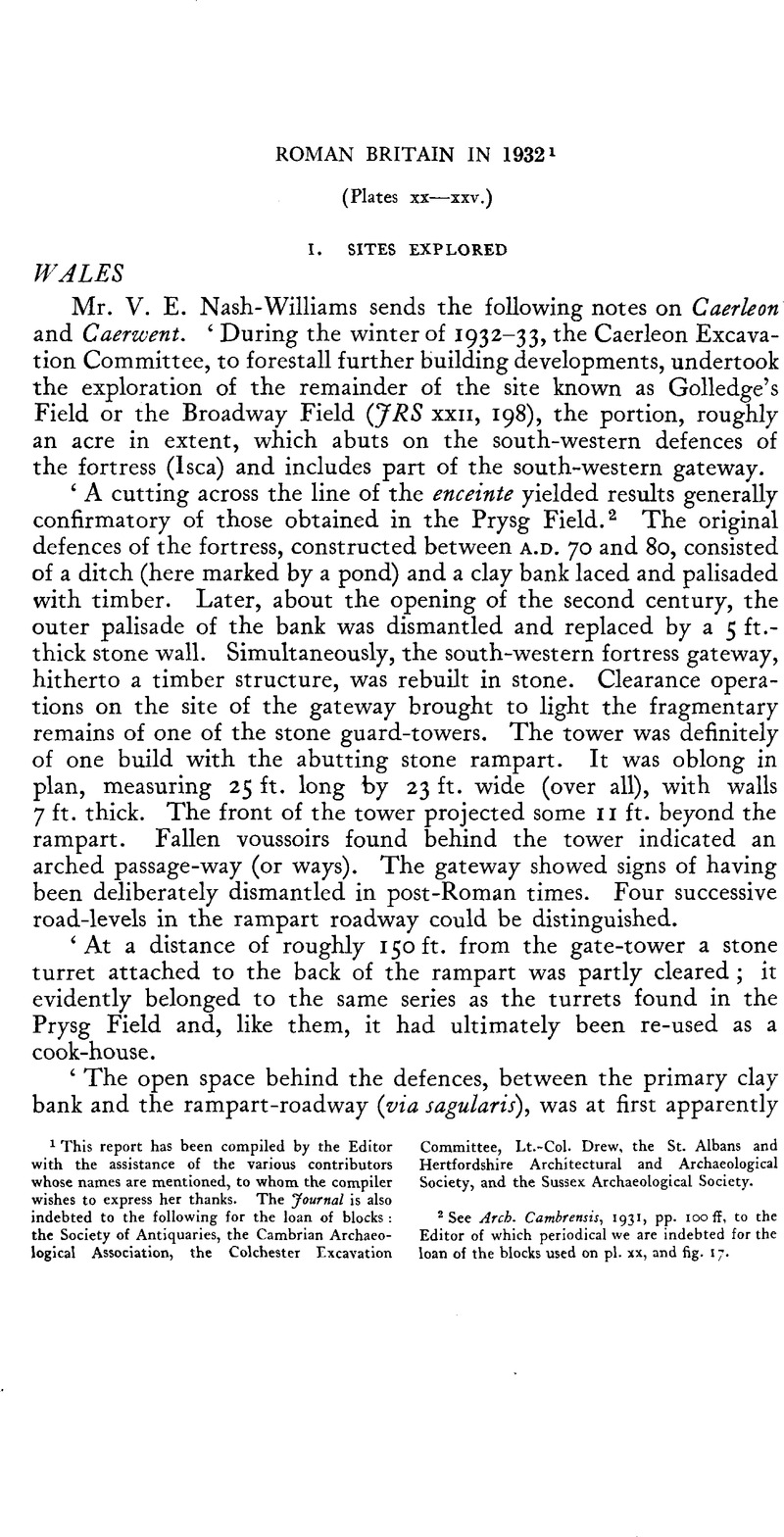No CrossRef data available.
Article contents
Abstract

- Type
- Research Article
- Information
- Copyright
- Copyright © 1933. Exclusive Licence to Publish: The Society for the Promotion of Roman Studies
References
2 See Arch. Cambrensis, 1931, pp. 100 ff, to the Editor of which periodical we are indebted for the loan of the blocks used on pl. xx, and fig. 17.
3 The south wall, cleared in 1925, is fully described in Archaeologia, lxxx, 251 ff.
4 Op. cit., p. 252, note, and p. 263.
5 See Arch. Ael., ser. 4, x, 97–101.
6 Proc. Soc. Ant. Newc., ser. 3, v. 132; cf. also no. 50a (Cumb. & Westmor. Arch. Soc. Trans. N.S., xiii, 307).
7 Arch. Ael., ser. 4, x, 83–96.
8 Cumb. & Westm. Arch. Soc. Trans. xxviii, 382.
9 Cumb. & Westm. Arch. Soc. Trans. ser. I, xvi, 81.
10 Yorks. Arcb. Journ., xxxi, 199.
11 Information and plans from Mr. P. H. Lawson, F.S.A.
12 The furnace is fully described by MrHannah, Ian in Antiqs. Journ., xii, 262 ff.Google Scholar
13 Geog. Journ., lxxix, 210 ff, 351 f, lxxxi, 149; Antiqs. Journ., xiii, 266 ff Cambr. Antiq. Proc. xxxiii, 108 ff.
14 Arch. Journ. lxxv, p. 36, no. 10 g.
15 Antiqs. Journ., xiii, 58.
l6 Brit. Mus. Catal. of Lamps, nos. 477 and 1021.
17 We are indebted to the St. Albans and Herts Archit. and Arch. Soc. for the loan of blocks used in figs. 12 and 13 and pl. xxii.
18 For the possible identification of the oppidum with the stronghold stormed by Caesar in the culminating moment of his British campaign in 54 B.C., see Antiquity vii, 1933, 21 ff.
19 An interesting imitation of a Samian bowl, form 37, in creamy-white clay, decorated with a version of the ovolo pattern in reddish-brown paint found in an unstratified site apparently near the north boundary of Walls Field, is published in Antiqs. Journ. xiii, 166, pl. xxvi.
20 JRS XXII, 210–12; Trans. Essex. Arch. Soc. xx, 270.
21 For a fuller report on the Committee's work, see Trans. Essex Arch. Soc. xxi, part I.
22 I owe this information to Mr. V. E. Nash-Williams.
23 See Wilts. Arch. Mag., xlvi, 70, pl. ii, where it is figured.
24 JRS XXII, 215, pl. 40.
25 Dorset Nat. Hist. and Antiq. Soc. Proc., liv, 16 ff., 23 ff.
26 ibid. p. 5 ff.
27 Information from Mr. Christopher Hawkes.
28 Sussex Arch. Coll. lxxiii, 203.
29 Hypocausts of this type though larger, found at Hambleden, Bucks, were held to have been used for corn-drying. Archaeologia, lxxi, 151 ff.
30 A full account by Dr. Curwen will be found in Antiqs. Journ., xiii, 109–151, to the Editor of which and Dr. Curwen we are indebted for plate xxiv.
3l JRS XIX, 210.
31 A See Sussex Arch. Coll. lxxiv, 164.
32 Sussex Arch. Coll. lxxiii, 33, lxxiv, 18 ff.; Sussex Notes & Queries, iv, 148; Surrey Arch. Coll. xl, 97 ff.
33 VCH Kent, iii 140.
34 Sussex Notes & Queries, iv, 151. We are indebted to the Editor of this periodical for the loan of the block used in fig. 16.
35 VCH Kent, iii, pp. 150 and 129.
36 Attention may be drawn to the excellent museum on the site; it has been arranged rather particularly for the use of students who can here study pottery of all kinds, coins and other objects, covering the whole period from A.D. 43 to the fifth century.
37 Grimes, W. F., ‘Holt, Denbighshire,’ Y Cymmrodor, xli, 130, 133.Google Scholar
38 Arch. Ael. ser. 4, x, 103; also pl. vii.
39 ibid. p. 108.
40 ibid. p. 109, f., pl. ix.




